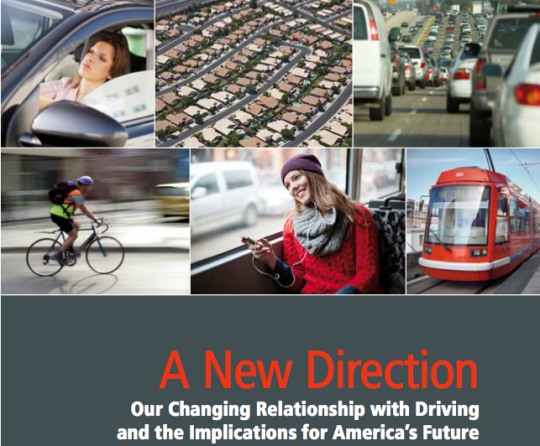
A report released today by Transportation for America and the OSPIRG Foundation calls on government agencies to “re-assess transportation policies” in light of continued statistical evidence that Americans are driving less.
“The slowdown in driving is likely to continue,” reads A New Direction: Our Changing Relationship with Driving and the Implications for America’s Future, “Baby Boomers are moving out of the phase in their life when they do the most commuting, while driving-averse Millennials [people born between 1983 and 2000] move into that phase. These demographic changes will likely keep driving down for decades.”
For years now, some transportation watchers have pointed to a decrease in the number of miles driven. While some see this as a major trend that requires a paradigm shift in our approach to transportation projects and policies, others see it as merely a statistical blip that will return to normal levels once the economy rebounds or young people get over the fad. However, as the number of miles driven in the U.S. heads down for the eighth straight year, this trend is becoming more difficult to ignore. Major cultural factors have permanently shifted and vehicle miles traveled has continued to decline even as GDP per capita goes up.
Here’s more from the report:
“The average American currently drives no more miles than at the end of President Clinton’s first term… The Millennial generation is leading the change in transportation trends. 16 to 34-year-olds drove a whopping 23 percent fewer miles on average in 2009 than in 2001— the greatest decline in driving of any age group.”
Here’s a chart from the report’s executive summary showing different scenarios of future travel growth:

Despite these trends, major highway projects are still being planned and funded based on assumptions based on an ever-increasing amount of auto traffic. We’ve seen this phenomenon play out in a major way by Columbia River Crossing supporters. They say future traffic will cripple Interstate 5 unless billions are spent to increase capacity. They also base toll revenue to pay for the project on assumptions of major increases in auto use well into the future. However, the stats paint a much different picture, as detailed in the excellent, Dude, Where are My Cars? series published by Sightline. And, as the report points out, even the federal government assumes a return to a steady increase in driving with official forecasts that are based on an increase of 44% to 67% in miles driven by 2040.
When I interviewed Oregon Department of Transportation Director Matt Garrett last year, he hinted that the driving decline it might simply be a phenomenon driven by trend-prone young people. Here’s how Garrett replied when I asked if he thinks driving levels might go back up:
“Well it could. Is it just a quick hit? Or is it truly a trend? … If it’s a trend that will demand a different calculus as we come to the table. The issue is, how long? Does that trend sustain as they get older? Maybe. I mean, there are generational issues, there’s no question about it. I know my daughter is happy with her bus pass, but as she gets a little older will that shift?”
Based on this detailed report, it indeed seems like a trend that must be met with a “different calculus” from ODOT and other agencies.
4America has clear motivations with their report. They’ve lobbied congress for years to stop investing in new highways and widening projects and instead put money into rebuilding existing roads and making them more accessible for walking and biking. This change in driving trends, says the report, will lead to toll roads being “less financially viable,” a reduction in traffic congestion, and “Many highway expansion projects will start to look like wasteful boondoggles,” while modes of transport that are increase in use — like bicycling and public transit — will be a smarter investment.
As Oregon readies for a major transportation funding package in 2015, the data and trends detailed in this report could play a large role in shaping the arguments for a new approach.
Learn more and download the report at OSPIRGFoundation.org.

